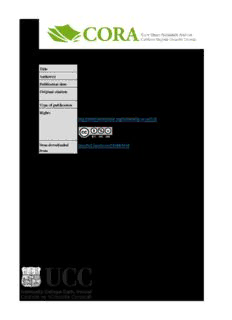
Antibiotic Resistance in the Gut Microbiota PDF
Preview Antibiotic Resistance in the Gut Microbiota
UCC Library and UCC researchers have made this item openly available. Please let us know how this has helped you. Thanks! Title Antibiotic resistance in the gut microbiota Author(s) Fouhy, Fiona Publication date 2014 Original citation Fouhy F. M. 2014. Antibiotic resistance in the gut microbiota. PhD Thesis, University College Cork. Type of publication Doctoral thesis Rights © 2014, Fiona Mary Fouhy. http://creativecommons.org/licenses/by-nc-nd/3.0/ Item downloaded http://hdl.handle.net/10468/3440 from Downloaded on 2022-12-25T09:16:10Z Antibiotic Resistance in the Gut Microbiota A thesis presented to the National University of Ireland for the Degree of Doctor of Philosophy By Fiona Mary Fouhy BSc Teagasc Food Research Centre, Moorepark, Fermoy, Co. Cork, Ireland School of Microbiology, University College Cork, Cork, Ireland. February 2014 Research Supervisors: Dr. Paul D. Cotter, Prof. Catherine Stanton, Prof. Gerald F. Fitzgerald, Prof. R. Paul Ross Table of Contents Declaration.................................................................................................................i Abstract......................................................................................................................ii ListofPublications..................................................................................................viii Glossaryofterms......................................................................................................x ListofFigures...........................................................................................................xv ListofTables..........................................................................................................xvii CHAPTER1 Compositionoftheearlyintestinalmicrobiota:knowledge,knowledgegaps andtheuseofhigh-throughputsequencingtoaddressthesegaps................1 1.1 Abstract...............................................................................................................2 1.2 Introduction.........................................................................................................3 1.3 Advancesintechniquestostudygutmicrobiota................................................4 1.4 Shapingtheearlyintestinalmicrobiota:Effectofmodeofdelivery..................12 1.5 Effectofearlyfeedingregime...........................................................................17 1.6 Impactoffamilystructure.................................................................................24 1.7 Effectofmaternalweight/diet...........................................................................25 1.8 Probiotics..........................................................................................................28 1.9 Prebiotics..........................................................................................................41 1.10Antibiotics........................................................................................................45 1.11Conclusions.....................................................................................................51 References..............................................................................................................53 CHAPTER2 High-throughputsequencingrevealstheincomplete short-term,recoveryoftheinfantgutmicrobiotafollowing parenteralantibiotictreatmentwithampicillinand gentamicin.............................................................................................................78 2.1Abstract.............................................................................................................79 2.2Introduction.......................................................................................................81 2.3MaterialsandMethods......................................................................................85 2.3.1Participants.....................................................................................85 2.3.2Generationof16SrRNAampliconsforhigh- throughputsequencing............................................................................85 2.3.3GenerationofBifidobacterium-derivedrpoB ampliconsforhigh-throughputsequencing..............................................87 2.3.4Bioinformaticanalysis.....................................................................87 2.3.5qPCR-basedquantificationoftotalbacteriaand totalbifidobacterianumbers....................................................................88 2.3.6Statisticalanalysis..........................................................................90 2.4Results..............................................................................................................91 2.4.1High-throughputsequencingof16SrRNA ampliconsfromthefaecalsamplesofantibiotic- treatedandcontrolinfants.......................................................................91 2.4.2Compositionofthegutmicrobiotaofantibiotic- treatedandcontrolinfants4weeksafterthe conclusionoftreatment............................................................................91 2.4.3Compositionofthegutmicrobiotaofantibiotic- treatedandcontrolinfants8weeksafterthe conclusionoftreatment............................................................................93 2.4.4qPCR-baseddeterminationoftotalbacteria andtotalbifidobacterianumbers.............................................................96 2.4.5Specificassessmentofthecompositionofthe gutBifidobacteriumpopulationinantibiotic-treated andcontrolinfants...................................................................................96 2.5Discussion.........................................................................................................98 References............................................................................................................106 CHAPTER3 AdegeneratePCR-basedstrategyasameansof identifyinghomologuesofaminoglycosideandβ-lactam resistancegenesinthegutmicrobiota............................................................127 3.1Abstract...........................................................................................................128 3.2Introduction.....................................................................................................130 3.3MaterialsandMethods....................................................................................133 3.3.1Recruitmentofvolunteers.............................................................133 3.3.2DNAextraction..............................................................................133 3.3.3PCR-baseddetectionofβ-lactamresistance genehomologues..................................................................................134 3.3.4PCR-baseddetectionofaminoglycoside resistancegenehomologues.................................................................135 3.3.5CloningofPCRamplicons............................................................136 3.3.6Bioinformaticanalysis...................................................................137 3.4ResultsandDiscussion...................................................................................138 3.4.1APCR-basedapproachhighlightsthe presenceofβ-lactamasegenehomologuesinthegut microbiota..............................................................................................138 3.4.2APCR-basedapproachhighlightsthe presenceofaminoglycosideresistanceencoding genehomologuesinthegutmicrobiota.................................................141 3.5Conclusions.....................................................................................................144 References............................................................................................................146 CHAPTER4 Insilicoassignedresistancegenesconfer Bifidobacteriumwithpartialresistanceto aminoglycosidesbutnotβ-lactams..................................................................160 4.1Abstract...........................................................................................................161 4.2Introduction.....................................................................................................163 4.3MaterialsandMethods....................................................................................167 4.3.1NCBIdatabasesearchforBifidobacterium- associatedβ-lactamandaminoglycosideresistance proteins..................................................................................................167 4.3.2Classificationofβ-lactamasesand aminoglycosideresistanceproteinsequencesfrom bifidobacteria.........................................................................................167 4.3.3Laboratorybasedassessmentsofantibiotic resistance..............................................................................................168 4.3.4DisruptionoftheBbr_0651andBbr_1586 genesfromB.breveUCC2003.............................................................170 4.3.5Complementationstudies.............................................................171 4.3.6Studiesofwild-typeB.breveUCC2003with additionalcopiesofaminoglycosideresistancegenes..........................172 4.3.7Heterologousexpressionofputative aminoglycosideresistancegenesinE.coli...........................................172 4.4Results............................................................................................................173 4.4.1Putativeβ-lactamasesassociatedwith Bifidobacteriumspecies.........................................................................173 4.4.2Putativeaminoglycosideresistanceproteins associatedwithBifidobacteriumspecies...............................................175 4.4.3Laboratory-basedassessmentoftheantibiotic resistanceofrepresentativebifidobacterialstrains...............................177 4.4.4DisruptionoftheBbr_0651andBbr_1586 genesofB.breveUCC2003..................................................................178 4.5Discussion.......................................................................................................182 References............................................................................................................191 CHAPTER5 Identificationofaminoglycosideandβ-lactamresistance genesfromwithinaninfantgutfunctionalmetagenomic library ..................................................................................................................215 5.1Abstract...........................................................................................................216 5.2Introduction.....................................................................................................218 5.3MaterialandMethods......................................................................................221 5.3.1Recruitmentofvolunteers.............................................................221 5.3.2DNAextraction..............................................................................221 5.3.3Metagenomicbankcreation.........................................................222 5.3.4Screeningforantibioticresistantclones.......................................223 5.3.5PCRanalysis................................................................................223 5.3.6Sequencingandanalysis..............................................................225 5.3.7Minimuminhibitoryconcentrationassays.....................................225 5.4Results............................................................................................................227 5.4.1Identificationofgentamicinandampicillin resistantcloneswithinafunctionalinfantgut metagenomicbank................................................................................227 5.4.2PCRandSangersequencingofβ-lactam resistantclones......................................................................................227 5.4.3PCRandSangersequencingof aminoglycosideresistantclones............................................................229 5.4.4MICanalysisofampicillinandgentamicin resistantclones......................................................................................231 5.5Discussion.......................................................................................................233 References............................................................................................................239 CHAPTER6 Gutmicrobialdiversityisreducedandisassociatedwith colonicinflammationinapigletmodelofshortbowel syndrome.............................................................................................................254 6.1Abstract...........................................................................................................255 6.2Introduction.....................................................................................................257 6.3MaterialandMethods......................................................................................260 6.3.1Animals.........................................................................................260 6.3.2Clinicalassessmentandgrowth...................................................260 6.3.3Experimentaldesign.....................................................................260 6.3.4Samplecollection..........................................................................261 6.3.5DNAextractionandampliconsequencing...................................261 6.3.6Bioinformaticanalysis...................................................................262 6.3.7QuantitativePCR..........................................................................263 6.3.8Real-timereversetranscriptionPCR(qRT- PCR)......................................................................................................263 6.3.9Microscopicassessmentofinflammation.....................................264 6.3.10Statisticalanalysis......................................................................265 6.4Results............................................................................................................266 6.4.1Pigletsthatreceivedasmallbowelresection hadapoorerclinicaloutcome................................................................266 6.4.2Totalcolonicbacterialnumberisunaltered followingsmallbowelresection.............................................................266 6.4.3Surgicalresectionofthesmallintestine decreasesbacterialdiversityinthecolon..............................................267 6.4.4Thecompositionofthepigmicrobiotaisaltered twoweeksaftersmallbowelresection..................................................267 6.4.5Smallbowelresectionleadstodysbiosisofthe gutmicrobiotasixweekspost-surgery..................................................268 6.4.6Thereisanincreaseincolonicinflammation followingsmallbowelresection,whichisassociated withdecreaseddiversity........................................................................269 6.5Discussion.......................................................................................................271 References............................................................................................................276 CHAPTER7 Themicrobialcompositionofthehumanappendixfrom patientsfollowingappendectomy.....................................................................295 7.1Abstract...........................................................................................................296 7.2Introduction.....................................................................................................298 7.3MaterialandMethods......................................................................................300 7.3.1Participants...................................................................................300 7.3.2Generationof16SrRNAampliconsfor454 sequencing............................................................................................300 7.3.3Bioinformaticanalysis...................................................................301 7.3.4qPCR-basedanalysis...................................................................302 7.3.5Statisticalanalysis........................................................................303 7.4Results............................................................................................................304 7.4.1qPCRanalysisofappendixsamples............................................304 7.4.2Compositionalhigh-throughputsequencing.................................305 7.4.3Individualvariationofthemicrobiotaofthe humanappendix....................................................................................305 7.4.4Sub-populationsofthemicrobiotaofthe appendix................................................................................................306 7.4.5Comparativeanalysisofthemicrobial compositionoftheappendixwiththemicrobiotaof thegut....................................................................................................308 7.5Discussion.......................................................................................................310 References............................................................................................................314 APPENDIX............................................................................................................325 1.0 ........................................................................................................326 2.0 ........................................................................................................366 3.0 .......................................................................................................393 DISCUSSION........................................................................................................417 ACKNOWLEDGEMENTS.....................................................................................436 Declaration I herebycertifythat thismaterial, which I nowsubmit for assessment onthe programmeof studyleading tothe award of PhD is entirelymyown work,and has not beensubmittedfor another degree, either at UniversityCollege Cork or elsewhere. Signed:________________________________________________ Fiona Mary Fouhy Date:_________________________________________________ i Abstract The human gut microbiota is altered by numerous factors, not least antibiotic exposure. This thesis sets out to investigate the effects of antibiotics on gut microbiota composition and its role as a reservoir for antibiotic resistance genes and, in doing so, highlight how new sequencing and molecular approaches can greatly enhance our knowledge in these areas. Currently, there is a paucity of studies applying high-throughput sequencing technologies to assess the effects of antibiotics on the infant gut microbiota. Thus, our aim was to investigate the effects of ampicillin and gentamicin treatment on these populations, compared to those in healthy controls, 4 and 8 weeks after antibiotic therapy ceased. DNA extracted from faecal samples was amplified using 16S rRNA and rpoB primers and was sequenced using 454-pyrosequencing. Four weeks post antibiotic therapy there was a significant increase in Proteobacteria and a significant decrease in Bifidobacterium in the gut microbiota of antibiotic treated infants, compared to the no antibiotic controls. By week 8 the levels of Actinobacteria had recovered, though Proteobacteria remained dominant in the treated infants. This is the first high-throughput sequencing study to demonstrate the significant short-term effects of antibiotics on infant gut microbiota. It is notable that it has recently been proposed that the human gut microbiota acts as a reservoir for antibiotic resistance genes. Our second goal was to investigate the presence of aminoglycoside and β-lactam iii
Description: